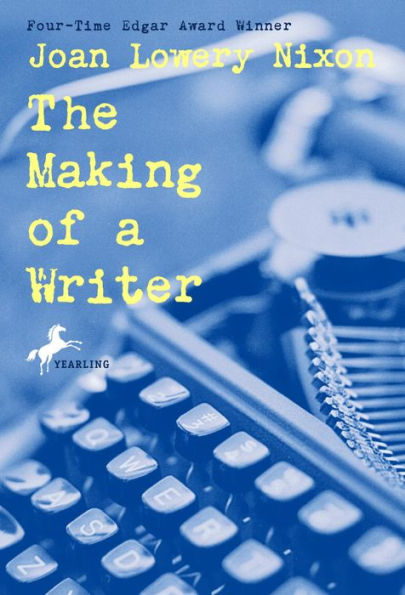The Making of a Writer
Joan Lowery Nixon is the acclaimed author of more than a hundred books for young readers. Over the years, many of her readers have written to her to ask how they, too, can become published writers someday. From her first publication at age ten to her graduation from Hollywood High during World War II, this memoir, which includes advice as well as anecdotes, is her answer. Listening to her favorite programs on the radio, performing puppet shows at orphanages and hospitals, and writing love poems for high school classmates to send to soldiers overseas all planted the seeds from which a prolific writing career grew.
Joan Lowery Nixon never forgot what her ninth-grade journalism teacher told her: “A writer must always have faith in herself. If you don’t believe in yourself, no one else will.” Both informative and entertaining, The Making of a Writer is a charming look at one writer’s beginnings.
“Nixon tucks her tips into a memoir that stands alone…A delightful look back at a time and a life.” –Booklist
“Her writing is clear and interesting, admirably blending her personal history, that of the nation, life lessons, and writing tips…[readers] will appreciate the insights she offers into her own life as well as the development of her signature style.” –VOYA
“A lively read…[with] clear and concise advice to writers.” –School Library Journal
“A lighthearted biography…It is a nicely focused take on something about the author.” –Kirkus Reviews
1005179564
Joan Lowery Nixon never forgot what her ninth-grade journalism teacher told her: “A writer must always have faith in herself. If you don’t believe in yourself, no one else will.” Both informative and entertaining, The Making of a Writer is a charming look at one writer’s beginnings.
“Nixon tucks her tips into a memoir that stands alone…A delightful look back at a time and a life.” –Booklist
“Her writing is clear and interesting, admirably blending her personal history, that of the nation, life lessons, and writing tips…[readers] will appreciate the insights she offers into her own life as well as the development of her signature style.” –VOYA
“A lively read…[with] clear and concise advice to writers.” –School Library Journal
“A lighthearted biography…It is a nicely focused take on something about the author.” –Kirkus Reviews
The Making of a Writer
Joan Lowery Nixon is the acclaimed author of more than a hundred books for young readers. Over the years, many of her readers have written to her to ask how they, too, can become published writers someday. From her first publication at age ten to her graduation from Hollywood High during World War II, this memoir, which includes advice as well as anecdotes, is her answer. Listening to her favorite programs on the radio, performing puppet shows at orphanages and hospitals, and writing love poems for high school classmates to send to soldiers overseas all planted the seeds from which a prolific writing career grew.
Joan Lowery Nixon never forgot what her ninth-grade journalism teacher told her: “A writer must always have faith in herself. If you don’t believe in yourself, no one else will.” Both informative and entertaining, The Making of a Writer is a charming look at one writer’s beginnings.
“Nixon tucks her tips into a memoir that stands alone…A delightful look back at a time and a life.” –Booklist
“Her writing is clear and interesting, admirably blending her personal history, that of the nation, life lessons, and writing tips…[readers] will appreciate the insights she offers into her own life as well as the development of her signature style.” –VOYA
“A lively read…[with] clear and concise advice to writers.” –School Library Journal
“A lighthearted biography…It is a nicely focused take on something about the author.” –Kirkus Reviews
Joan Lowery Nixon never forgot what her ninth-grade journalism teacher told her: “A writer must always have faith in herself. If you don’t believe in yourself, no one else will.” Both informative and entertaining, The Making of a Writer is a charming look at one writer’s beginnings.
“Nixon tucks her tips into a memoir that stands alone…A delightful look back at a time and a life.” –Booklist
“Her writing is clear and interesting, admirably blending her personal history, that of the nation, life lessons, and writing tips…[readers] will appreciate the insights she offers into her own life as well as the development of her signature style.” –VOYA
“A lively read…[with] clear and concise advice to writers.” –School Library Journal
“A lighthearted biography…It is a nicely focused take on something about the author.” –Kirkus Reviews
4.99
In Stock
5
1

The Making of a Writer
112
The Making of a Writer
112
4.99
In Stock

Product Details
| ISBN-13: | 9780307820464 |
|---|---|
| Publisher: | Random House Children's Books |
| Publication date: | 09/25/2013 |
| Sold by: | Random House |
| Format: | eBook |
| Pages: | 112 |
| File size: | 2 MB |
| Age Range: | 10 Years |
About the Author

From the B&N Reads Blog
